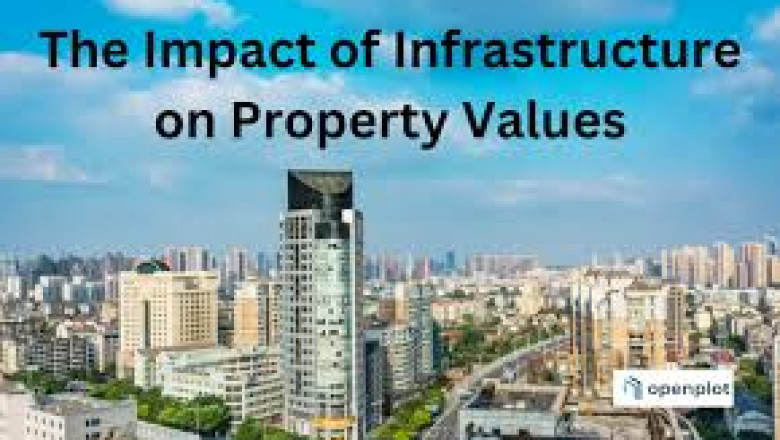views
For homebuyers, investors, and developers alike, understanding how infrastructure influences property prices is critical. This article delves into the intricate relationship between infrastructure and real estate value, examining how new developments can turn overlooked areas into high-demand real estate hotspots.
1. Defining Infrastructure in Real Estate Context
In real estate, infrastructure refers to the basic physical and organizational facilities needed for the operation of a society. This includes:
-
Transport Infrastructure: Roads, railways, metro lines, airports, ports, bus terminals.
-
Utilities: Water supply, electricity, sewage systems, internet, and gas pipelines.
-
Social Infrastructure: Schools, hospitals, parks, public offices, and recreational centers.
-
Digital Infrastructure: Broadband connectivity, smart surveillance, and digital civic systems.
Each of these components plays a vital role in shaping the desirability and value of a property.
2. Enhanced Connectivity = Increased Demand
One of the most visible effects of infrastructure development is improved connectivity. A neighborhood that once took an hour to reach from the city center might become accessible in just 20 minutes after the introduction of a metro line or a new expressway.
This ease of travel reduces commuting time, boosts productivity, and improves the quality of life. As a result, areas with enhanced connectivity see:
-
Surge in buyer interest
-
Rise in property transaction volumes
-
Increase in rental yields
-
Long-term appreciation in land value
A classic example in India is the Delhi Metro expansion, which significantly boosted property prices in suburbs like Noida, Ghaziabad, and Faridabad.
3. The Ripple Effect of Major Projects
Large-scale infrastructure projects often trigger a domino effect. For example, the announcement of a new airport doesn't just improve air connectivity—it creates job opportunities, demands hospitality and commercial zones, and attracts both residential and retail development.
Case in point: The upcoming Navi Mumbai International Airport has led to a surge in property demand in areas like Panvel and Ulwe, which were earlier considered underdeveloped.
Infrastructure development attracts ancillary businesses and stimulates economic activity, further driving up real estate value.
4. Social Infrastructure Enhances Livability
While transport and utility infrastructure are critical, social infrastructure determines the long-term viability and desirability of a neighborhood.
People are willing to pay more to live near:
-
Reputed schools and colleges
-
Well-equipped hospitals
-
Clean and secure public parks
-
Shopping complexes and multiplexes
The presence of social infrastructure not only improves quality of life but also adds emotional and functional value to properties, especially among families and senior citizens.
5. Infrastructure as a Real Estate Investment Indicator
For investors, upcoming infrastructure projects serve as early indicators of growth. Buying property in a location that is part of a planned development corridor or smart city initiative can deliver high ROI if timed right.
However, it’s important to verify the status of the infrastructure project:
-
Is it approved or just proposed?
-
What stage is the project in—planning, funding, or construction?
-
Is it government-backed or a PPP (public-private partnership)?
-
Are there environmental or legal hurdles?
Being informed helps investors make calculated decisions instead of speculative ones.
6. Appreciation Patterns: Before vs. After Development
The real estate market generally follows this pattern:
-
Pre-development phase: Prices remain relatively low; early investors can enter the market affordably.
-
Construction phase: Prices begin to rise due to anticipation and partial impact.
-
Post-completion phase: Sharp spike in property value; resale demand and rental demand increase.
Timely entry in the pre-development stage allows buyers to maximize gains. This is why staying updated on infrastructure announcements from municipal bodies or urban development authorities is essential.
7. Challenges and Cautions
While infrastructure boosts property prices, there are also challenges to consider:
-
Delays: Infrastructure projects in India often face delays due to funding, land acquisition, or legal issues.
-
Overhype: Sometimes, speculative buying drives prices up without real demand, leading to artificial inflation.
-
Displacement and Disruption: Construction activity may cause noise, pollution, and even temporary drop in livability.
-
Gentrification: Rapid development can push out long-term residents due to rising living costs.
A wise buyer or investor must balance opportunity with due diligence.
8. Case Studies from Indian Cities
Bengaluru
The expansion of the Namma Metro has transformed areas like Whitefield, Yelahanka, and Kanakapura Road. Property prices surged by 20–30% over a few years due to improved connectivity.
Hyderabad
The Hyderabad Metro and Outer Ring Road development pushed up prices in Hitec City, Gachibowli, and Uppal. IT growth combined with transport infrastructure created new micro-markets.
Chennai
Upcoming infrastructure like the Chennai Metro Phase II and elevated expressways is increasing property activity in localities like Porur, Madhavaram, and Poonamallee.
9. Smart Infrastructure and Digital Transformation
With the rise of smart cities, infrastructure isn’t just physical—it’s digital too. High-speed internet, surveillance systems, smart traffic control, and e-governance portals add another layer of desirability to urban areas.
Properties in smart zones or tech-enabled societies attract millennials, remote workers, and tech professionals, boosting both rentability and resale value.
Conclusion
Infrastructure development is the backbone of real estate growth. Whether it's improving travel, enhancing lifestyle, or creating economic opportunities, infrastructure plays a pivotal role in determining where people want to live—and what they’re willing to pay.
By understanding the impact of new projects and tracking development trends, homebuyers and investors can make smarter, future-proof decisions.
So, the next time you're considering a property, don’t just look at the building—look at what’s being built around it.
This article is brought to you by Hexahome, your trusted partner in modern real estate solutions, and Hexadecimal Software, a leader in real estate technology, providing smart tools and insights to help you stay ahead of the property curve.














Comments
0 comment